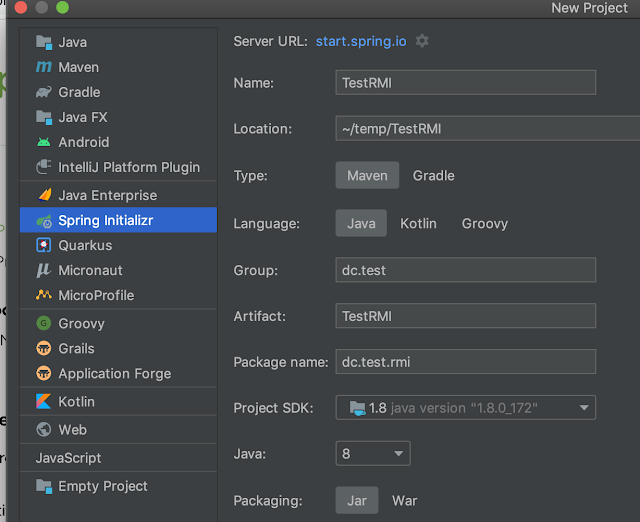自带的RMI
定义三个module,分别为 api、client、server。
其中api提供Bean及接口,server实现接口,client调用接口。从而实现client调用server。
TestRMI -> Spring Web项目
配图1,项目基本配置
报错 Remote host terminated the handshake.看起来是网络问题
关掉本地代理,用路由器代理就好了。。。。
打开项目,是一个默认的spring web结构,配图2
删掉各种目录,只留 .idea、pom、iml这仨文件即可。
然后新建module:api、server、client。
子项目直接用脚手架创建,配图3
1,api 定义接口及Bean
如 UserBean implements Serializable,需要实现序列化
及interface IUserService.
public interface IUserService { /** * 获取用户根据ID * * @param userId 用户ID * @return UserBean */ UserBean findUserById(Integer userId); }
2,Service实现
service 模块,实现api中接口,添加@Service注解
import org.springframework.stereotype.Service; @Service public class UserServiceImpl implements IUserService { @Override public UserBean findUserById(Integer userId) { UserBean bean = new UserBean(); String name = "默认用户"; switch (userId) { case 1: name = "张三"; break; case 2: name = "李四"; break; case 3: name = "王五"; break; default: break; } bean.setId(userId); bean.setName(name); return bean; } }
定义RMI Config, 用于对外暴露
import org.springframework.beans.factory.annotation.Autowired; import org.springframework.context.annotation.Bean; import org.springframework.context.annotation.Configuration; import org.springframework.remoting.rmi.RmiServiceExporter; @Configuration public class RmiConfig { @Autowired private IUserService userService; @Bean public RmiServiceExporter serviceExporter() { RmiServiceExporter exporter = new RmiServiceExporter(); exporter.setService(userService); exporter.setServiceInterface(IUserService.class); exporter.setRegistryPort(2022); exporter.setServiceName("userService"); return exporter; } }
定义启动类
@SpringBootApplication public class ServerApplication { public static void main(String[] args) { SpringApplication.run(ServerApplication.class, args); } }
resource.yaml中,配置启动端口
3,client中调用
定义调用业务
@Component public class UserClient implements CommandLineRunner { @Autowired private IUserService userService; @Override public void run(String... args) throws Exception { System.out.println("用户1 is " + userService.findUserById(1)); System.out.println("用户2 is " + userService.findUserById(2)); System.out.println("用户3 is " + userService.findUserById(3)); System.out.println("用户4 is " + userService.findUserById(4)); } }
获取rmi中暴露的Service
@Configuration public class RmiConfig { @Bean(name = "userService") public RmiProxyFactoryBean proxyFactoryBean() { RmiProxyFactoryBean bean = new RmiProxyFactoryBean(); bean.setServiceUrl("rmi://127.0.0.1:2022/userService"); bean.setServiceInterface(IUserService.class); return bean; } }
定义启动类
@SpringBootApplication public class ClientApplication { public static void main(String[] args) { SpringApplication.run(ClientApplication.class, args); } }
修改端口为8082
4,运行
先启动Service,后启动client
用户1 is UserBean{id=1, name='张三'}
用户2 is UserBean{id=2, name='李四'}
用户3 is UserBean{id=3, name='王五'}
用户4 is UserBean{id=4, name='默认用户'}
获取成功。
可以说是一个非常简单的demo了。。。。
对微服务的理解还是有一定帮助的。。。。
senRsl
2022年06月09日17:29:22






没有评论 :
发表评论